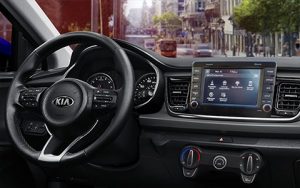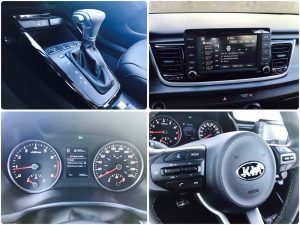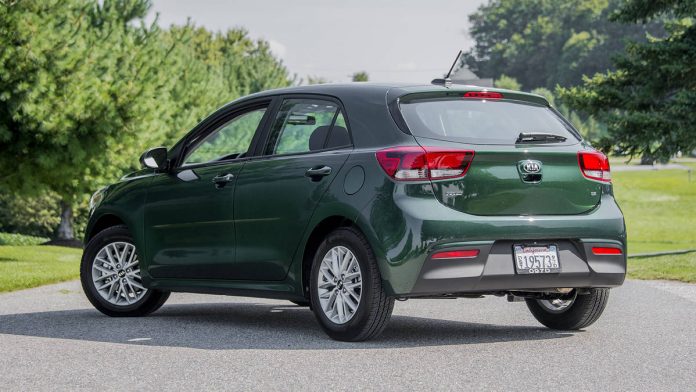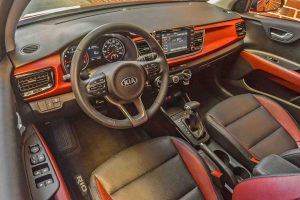Kia and Hyundai are – today – like Ford and Mercury used to be. Well, Mercury no longer is at all. But once upon a time, Mercury was the higher-line (and sightly higher-priced) version of the same basic thing sold under the Ford label. Kia serves the same purpose today. Its models are Hyundai models, slightly sportier in looks than their Hyundai counterparts – and priced a bit less.
For instance, the Kia Rio. Under the skin, it’s a Hyundai Accent.
But you can save about $800 by going with the Kia version – besides which, you may prefer its sportier-looking skin.
Or the fact that you can still get it in five-door hatchback form.
WHAT IT IS
The Rio is the Kia version of the Hyundai Accent t. Or the reverse. Either way, it’s the same basic thing – and the identical thing, under the skin. Same engine, same standard and available transmissions. Same overall length (sedan versions) and wheelbase and interior dimensions.
The main difference is Rio version stickers for $14,200 to start; the same basic ride with a Hyundai badge (and skin job) lists for $14,995 to start – a difference of $795. Also, that the Kia-badged versions come two ways- sedan and hatchback. The Hyundai-badged version is now sedan only. 
Main rivals include similarly priced small sedans/hatchbacks like the Ford Fiesta ($14,115 to start), the Toyota Yaris iA ($15,950 to start) and the Nissan Versa ($12,110 to start).
The Kia (and Hyundai) offer a bit more power than these rivals – as well as a standard six-speed manual vs. the five-speed manuals that are standard in all of the above.
WHAT’S NEW
Both the Rio and its Hyundai-badged fraternal cousin are significantly updated inside and outside for 2018.
They’re also slightly longer than before – but the most noticeable and meaningful change is a much roomier back seat. Almost 2.5 inches more legroom (vs. the 2017 models) has been carved out, with the extra margin making these cars much more viable as primary/family cars as opposed to commuter/single people’s cars.
WHAT’S GOOD
Peppier than Yaris, Versa and Fiesta.
Six-speed manual vs. five-speed manuals in rivals.
More backseat room than before.
Sedan and cargo-friendlier five-door bodystyles available.
Inexpensive – but not downtrodden.
AC, intermittent wipers, tilt wheel, a good stereo and a 5-inch LCD display are standard equipment in base-priced LX.
WHAT’S NOT SO GOOD
Others in this class have roomier back seats.
Others are lower-priced (and also not downtrodden).
Manual only available in base LX trim; higher trims are automatic-only.
Base LX trim sedan’s rear seats don’t fold. Bluetooth not included – and not offered.
Like the other cars in this class, the Rio (and Accent) both come with a small (1.6 liter) four cylinder engine.
The main difference being the higher power output of the the Kia/Hyundai’s engine.
It produces 130 hp, down a bit from last year’ 138 – but still a standout vs. the 109 hp made by the Nissan Versa’s same-size (1.6 liter) engine and the Yaris iA’s smaller-size (1.5 liter) engine, which manages just 106 hp.
The Ford Fiesta’s 1.6 liter engine comes closer – 120 hp – but is still 10 shy.
While not exactly speedy – zero to 60 takes about 8.7 seconds – the Rio is quicker than most of its rivals in the class. And the Rio feels speedier because it’s got tighter gearing, courtesy of the six-speed manual gearbox vs. the wider-ratio five speed boxes in rivals like the Versa, Yaris and Fiesta.
Also worth a mention is the fact that the Kia (and Hyundai’s) optional automatic is a conventional (hydraulic, with a torque converter) six-speed automatic. Some of the other cars in this class have continuously variable (CVT) automatics – and one (the Ford Fiesta) has a dual-clutch automated manual transmission. While the former and the latter have their pros – greater efficiency for the CVT, quicker shifts for the dual-clutch automated manual – they also have their cons.
A CVT-equipped car, especially if it hasn’t got much power, can feel – and sound – as though it has even less power than it does. The CVT is designed to get the engine to rev to the spot in its powerband where it makes the most power. But small engines such as the ones in this class don’t make a lot of power – and what power they do make is usually above 5,000 RPM. So what happens when you push down hard on the accelerator is . . . the engine accelerates to high RPM and stays there, making a lot of noise all the while. There’s no downshift to a lower gear (which would lower the engine RPM and so, the noise) because CVTS don’t downshift (or upshift). They simply rev-match the engine to road speed/driver demand for acceleration.
This works well in cars with reserve power – or with engines that make a lot of power at lower engine RPM. But in cars in this class, without much extra on tap . . . .
And dual-clutch transmissions? They are extremely elaborate transmissions. If it ever fails, post-warranty, you could be looking at a bill not worth paying relative to the value of the car itself. Dual-clutch transmissions may make sense in high-end (and high-performance) cars, where their ultra quick shifting capabilities are a plus and their high repair/replacement costs less an issue. But in $15k-ish cars, a transmission that could cost you $4k to replace if it ever fails seems like a not-so-great idea.
But the main criteria for cars in this class isn’t speed – it’s economy. And on that score, the Rio scores well: 28 city, 37 highway with the standard six-speed manual; slightly better (29 city, 37 highway) with the optional six-speed automatic.
This isn’t quite as fuel-efficient as the class-best Yaris iA – 32 city, 40 highway with its optional automatic – but it’s close enough to be within the margin of error. Or at least, close enough that individual driving habits will probably make the real-world differences negligible.

What could have made a real difference – and does, in Europe – is the 1.4 liter turbodiesel engine you can buy in a Rio everywhere except here. Equipped with that engine, the 2,648 pound Kia is capable of 50-plus miles-per-gallon – mileage right there with a hybrid Prius but for about $7,000 less up front.
It’s an outrage such engines have been fatwa’d out of existence in this country – on the basis of specious, recondite emissions criteria. A literally fractional difference in this or that emission from this “bin” or “tier” (as EPA classifies things) to the next-up “bin” or “tier.”
On the order (or magnitude) of 0.002 vs. 0.003 parts per million and such like. This is what we’re talking about, or rather, what federal regulatory bureaucrats obsess about – like Medieval clergymen debating how many angels can dance on the head of a pin.
Meanwhile, we get cars that are 20 percent less efficient. Whole numbers less efficient. Double digit whole numbers less efficient.
You’d think the government bureaucrats and politicians who warble constantly about conservation would move heaven and earth to encourage Kia (and Hyundai) to offer the high-mileage diesel in the U.S.
This, of course, assumes these bureaucrats and politicians so warbling actually are “concerned” – that’s the word they like so much – about conservation.
They’re obviously not.
We really have it good.
The historically defining attribute of an “entry level” car – feebleness combined with noisyness – is no longer an attribute. Of the Kia’s or any of the models it competes with. Or any new car, period.
Back in the not-so-long-ago mid-’90s, an entry level car – a Geo Metro, for instance – took nearly 13 long (and loud) seconds to haul itself to 60.
And by 60 it was approaching its Top Speed.
The Rio has power to spare. It will easily do 100-plus and 80 is just cruising. Rarely is it necessary to floor it. There is ample power for merging and pulling away from traffic – not merely keeping up with it. The others it competes with are also competent in this respect but the Kia is a bit more so because it has a bit more power.
On paper, there is a bit less power than las year (130 vs. 138 previously) but – like other modern “entry level” engines, the Kia’s engine is a high-compression (11.0:1) and high-performance engine for its displacement.
The take-home point is you’ll never feel left behind . . . unless you try to race a 416 hp supercar.
Having more than enough power for everyday driving means relaxed driving and quiet driving. I took a friend of mine for a ride in the Rio; he was surprised by how not-noisy this “entry level” car was.
Not just the engine, either.
Another no-longer-defining attribute of inexpensive cars is lack of road and wind noise. It’s not as tomb-quiet in a car like the Rio as it is inside say a Mercedes S Class. But – as opposed to the entry level cars of the not-so-distant past – you don’t need to raise your voice in proportion to the speed you’re driving to maintain a conversation.
You won’t hurl wheelcovers like frisbees in the curves – in the first place because the Kia hasn’t got those cheesy pop-on wheel covers, as entry-level cars used to have. In the second because the Kia has probably twice the cornering grip of a ’90s-era entry level car and three or four times better ride quality.
Wait. There’s one more point of departure from the entry level cars of recent vintage.
Two, actually.
Appearance and amenities.
This is not a sad – much less cheap-looking – car. View a picture of a ’90s-era Metro, Chevy Cavalier or Ford Escort to behold one of those.
Now have a look at one of these.
At both of these.
Unlike its Hyundai-badged brother, the Rio is available in sedan or five-door hatchback versions. The 2018 Accent is sedan-only, for reasons known only to the emperor. The hatchback is arguably the pick of the litter, if you want a small car with more room. It has more than twice the total cargo capacity – 32.8 cubic feet vs. 13.7 for the sedan – and the open floorplan layout of the hatchback (the cargo area is expandable to include the rear seat area, when the seats are folded flat) makes the space more accessible and usable.
And there’s another bonus.
The hatchback is more compact than the sedan – 160 inches long overall vs. 172.6 inches – which opens up curbside parking spots the sedan has to pass by.
Both versions have roomier interiors – and the same first and second row head and legroom stats. The Rio’s rear legroom has been upsized to 33.5 inches (from 31.1 inches previously) which gives it a bit more backseat legroom than rivals like the Fiesta (31.2 inches) and almost as much legroom as rivals like the Yaris iA 34.4 inches) which by the way is a rebadged Mazda sold under the Toyota label.
None of these have as much backseat legroom as the Nissan Versa, though. It has a stupendous 37 inches of backseat legroom – which is more legroom than several mid-sized luxury cars.
Both the sedan and the five-door sit lower – and wider – than before and each rides on a slightly longer wheelbase. Neither has the demeanor of a cheapster – except insofar as what you are asked to pay for one.
Other cars are larger or cost more and have or offer more features – but calling any of these cars “entry level” is dated terminology. The Rio/Accent – like their rivals – may be their respective manufacturers’ most inexpensive models, but the connotation of cheapness that attends “entry level” is as out-of-date as The Flintstone’s song about having a gay old time.
One of the other nice things about these “entry level” cars is they are not – yet – addled by the uber Nanny technology that is turning higher-end cars into electro-mechanical mothers-in-law, second-guessing everything you do behind the wheel – braking when it thinks you should, harassing you with lights and buzzers when you don’t drive the way it thinks you ought to.
If you wants some of thus stuff – such as automated braking, for instance – it’s available. But – thankfully – it is optional.
One small disappointment is that the base LX trim doesn’t include Bluetooth, which means no wireless piping of your music from you device to the car. But there is a USB port, so you an still do it – just not wirelessly.
One interesting thing is that the base trim LX comes with manual roll-up windows. These are a rare thing to find in a new car – even “entry level” cars. Most of the Kia’s rivals come standard with power windows. But not everyone wants them. Power windows may be more convenient, but they cost more to fix when the electric motors fail – which they will, eventually. Manual roll-up windows, meanwhile, are simpler – and purely mechanical -things that usually last the life of the car.
One great thing is this car still has a manual, pull-up lever emergency brake. No electronic “eBrake.” Also, no automatic engine start/stop idiocy, either.
Get it while you still can.
THE BOTTOM LINE
Why buy MD 20/20 when you can get a damned good bottle of red – or white – for about the same price?
. . .
Got a question about cars – or anything else? Click on the “ask Eric” link and send ’em in!
If you like what you’ve found here, please consider supporting EPautos.
We depend on you to keep the wheels turning!
Our donate button is here.
If you prefer not to use PayPal, our mailing address is:
EPautos
721 Hummingbird Lane SE
Copper Hill, VA 24079
PS: EPautos magnets – they’re back! are free to those who send in $20 or more to support the site. Also, the eBook – free! – is available. Click here. Just enter you email in the box on the top of the main page and we’ll email you a copy instantly!
xxx




















Hi Eric, I hate to be the Math Nazi but your power output comparison (3.2 liter V6 that made the same power-per-liter would make 416 horsepower) is not correct. The Rio’s engine is 1.6L and makes 130 hp. At the same specific output, a 3.2L engine (twice the displacement) would make 260 hp (twice the power). In your miscalculation, I think you used 130 hp as the output per liter rather than the total engine power produced by 1.6L.
Has this the self carbonizing injection system?
Hi Eric,
It does, unfortunately… pretty much everything new does. There are still a few stragglers, but it won’t be long now…
Hi Eric, the Rio sounds like a great little car for the price. Too bad the rear seats don’t fold on the hatchback version. Question: does it have a regular emergency break or electric?
Hi Stu,
It has a regular pull-up emergency brake lever!
I need to add that to the article – hat tip for the reminder 🙂